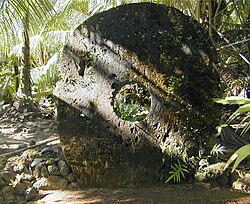
Back Ахаҳәқәа Раи Abkhazian Fei-klippe Afrikaans Камяні Раі BE-X-OLD Камъни Раи Bulgarian Pedres rai Catalan Rai (peníze) Czech Rai (Währung) German Ŝtonmono rai Esperanto Piedras rai Spanish Monnaie de pierre French

A rai stone (Yapese: raay),[1] or fei stone,[2] is one of many large artifacts that were manufactured and treasured by the native inhabitants of the Yap islands in Micronesia. They are also known as Yapese stone money or similar names.
The typical rai stone is carved out of crystalline limestone and shaped like a disk with a hole in the center. The smallest may be 3.5 centimetres (1.4 in) in diameter. The largest extant stone is located on Rumung island, near the Riy village; it is 3.6 metres (12 ft) in diameter and 50 centimetres (20 in) thick, and weighs 4,000 kilograms (8,800 lb).[3][4]
Rai stones were quarried on several of the Micronesian islands, mainly Palau,[5] but briefly on Guam as well. The practice stopped in the early 20th century. Today around 6,000 large rai stones are outstanding on the island,[clarification needed] and several can be seen in museums worldwide.[6][7]
The stones were highly valued by the Yapese and used for important ceremonial gifts. The ownership of a large stone, which would be too difficult to move, was established by its history as recorded in oral tradition rather than by its location. Appending a transfer to the oral history of the stone thus effected a change of ownership.[3]
Some modern economists have viewed Rai stones as a form of money, and the stones are often used as a demonstration of the fact that the value of some forms of money can be assigned purely through a shared belief in said value.[3][8]
- ^ "Raay2". Yapese Dictionary. Updated 27 July 2012. Retrieved 25 November 2013.
- ^ Cite error: The named reference
rainwas invoked but never defined (see the help page). - ^ a b c Gillilland, Cora Lee C. (1975). The Stone Money of Yap. A Numismatic Survey. (Smithsonian Studies in History and Technology 23). Washington, DC: Smithsonian Institution Press. p. 75.
- ^ "Rai of Yap – the stone money". Wondermondo. 13 November 2011.
- ^ G. S. Parsonson (1962). "The Settlement of Oceania: An Examination of the Accidental Voyage Theory". Journal of the Polynesian Society, Auckland University. Archived from the original on 12 September 2019. Retrieved 19 September 2016.
The natives of Yap in Micronesia went 300 miles to the Palau Islands for "stone money", great calcite disks, six to twelve feet in diameter.
- ^ Patterson, Carolyn Bennett, et al. "At the Birth of Nations: In the Far Pacific". National Geographic Magazine, October 1986, page 498. National Geographic Virtual Library.
- ^ "Metuker ra Bisech – Yapese Quarried Stone Money Site". AiraiState.com. Archived from the original on 20 August 2013.
- ^ Cite error: The named reference
friedwas invoked but never defined (see the help page).